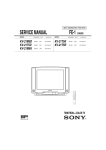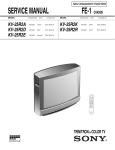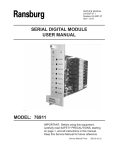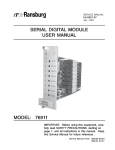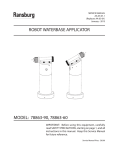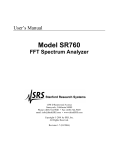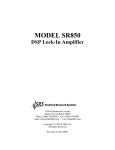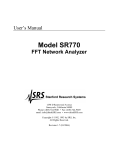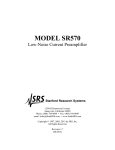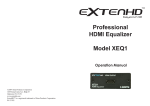Download Sine Systems AFS-3 Specifications
Transcript
Audio Failsafe Model AFS-3 – INSTALLATION AND OPERATION – This documentation is valid for Audio Failsafe hardware version 3.0 and software version 1.0 Nashville, Tennessee • 615-228-3500 Table of Contents Section I – Safety Information / Warranty 1.1 Safety Information Page Number 1.1 Section 2 – System Descriptions 2.1 2.2 2.3 2.3.1 2.3.2 2.3.3 General Description Physical Description Electrical Description Front Panel Indicators Normal/Defeat Switch Delay Adjustment 2.1 2.2 2.1 2.1 2.1 2.1 Section 3 – Installation 3.1 3.2 3.2.1 3.2.2 3.2.3 3.2.4 3.2.5 3.2.6 3.2.7 3.2.8 3.2.9 3.2.10 System Includes Installing the Unit Screw-Terminal Connectors Power Supply Connection Audio Inputs Delay Adjustment Relay Connections Logic Voltage Output Audible Alert Enable/Disable Audio/Silence Detector Power Supply Loss Safety Considerations 3.1 3.1 3.1 3.1 3.1 3.2 3.2 3.3 3.3 3.3 3.4 3.4 Section 4 – Circuit Description and Repair 4.1 4.2 4.2.1 4.2.2 4.2.3 4.2.4 4.2.5 4.2.6 Circuit Description Factory Service Policy Factory Warranty Factory Return Policy Factory Service Policy Warranty Service Service Rates Instructions for Factory Service 4.1 4.1 4.1 4.1 4.2 4.2 4.2 4.2 Section 5 – Specifications 5.1 5.2 5.3 5.4 5.5 AFS-3 General Specifications Audio Input Relay Output Schematic Diagram Component Layout 5.1 5.1 5.1 5.2 5.3 Table of Contents i Section 1 — Safety Information 1.1 Safety Information ! The AFS-3 Audio Failsafe should be installed only by qualified technical personnel. An attempt to install this device by a person who is not technically qualified could result in a hazardous condition to the installer or other personnel, and/or damage to the AFS-3 or other equipment. Please ensure that proper safety precautions have been made before installing this device. If the AFS-3 is connected so that loss of audio turns a transmitter off, the return of audio could turn the transmitter back on. Operating and maintenance personnel should be mindful of this possibility and be sure the transmitter is rendered inoperable before servicing the transmitter, antenna, or associated equipment. The purchaser and user of the Sine Systems AFS-3 Audio Failsafe bears the sole responsibility for determining suitability of this equipment for their intended use. The AFS-3, as any electronic device, can fail in unexpected ways and without warning. Do not use the AFS-3 in applications where a life-threatening condition could result if it were to fail. Sine Systems, Inc. cannot be held responsible for damages, either direct or indirect, resulting from use of this equipment. Even though the AFS-3 is powered by 12 volts AC from a "wall plug" transformer, failure of this transformer could cause dangerous and potentially lethal voltages to become present. Only the supplied transformer should be used. The AFS-3 is designed for indoor use in a dry location. Installation and operation in other locations could be hazardous. AFS-3 Safety Information page 1.1 Section 2 — System Descriptions 2.1 General Description The AFS-3 monitors one or two audio signals and provides a relay contact closure as long as at least one of the audio signals is present. When no audio is present for a preset period (adjustable from 30 seconds to 5 minutes), the relay contact opens and remains open until one or both of the audio signals return. A typical application of the AFS-3 is to provide alternate control for a remotely controlled broadcast transmitter. When appropriately installed, the AFS-3 can be used to turn off a transmitter by silencing the audio feed to the transmitter. This procedure would normally be used only when the normal remote control device has failed. 2.2 Physical Description The AFS-3 is contained in a 19 inch wide rack mounted case, 1.75 inches high. The front panel contains indicator LED’s and a switch to force closure of the relay contacts and defeat operation of the AFS-3. The rear panel contains “pluggable” screw-terminal connectors for connecting the audio inputs, power, and relay connections. Power Enabled Audio Alert Dual-Channel Audio Failsafe model AFS-3 Normal Defeat Remote Facilites Controller Accessory Sine Systems , inc Figure 2.1; AFS-3 front panel 2.3 Electrical Description 2.3.1 Front-Panel Indicators The front panel of the Audio Failsafe contains four LED indicators: • • • • 2.3.2 "Power" illuminates when the AFS-3 has power "Enabled" illuminates when the Normal/Defeat switch is in the Normal position "Audio" illuminates when the AFS-3 detects audio "Alert" illuminates when the system is in alert condition Normal/Defeat Switch The front panel of the Audio Failsafe contains a pushbutton switch. In the Normal position the switch allows the relay to follow the audio. When audio is present the relay closes (contact between NO and C). When audio is absent for the preset delay period, the relay relaxes (no contact between NO and C). In the Defeat position, audio is still detected but the relay is forced into the relaxed position. This logic may be reversed by using the normally closed (NC) contact in place of the normally open (NO) contact. 2.3.3 Delay Adjustment The rear panel of the AFS-3 has a rotary switch that adjusts the detection delay. The delay setting determines the length of time that must elapse for the alert to occur. For example, if the delay is set to 30 seconds then the system must detect silence continuously for 30 seconds before the alert condition will be triggered. AFS-3 System Descriptions page 2.1 Section 3 — Installation ! The AFS-3 Audio Failsafe should be installed only by qualified technical personnel. An attempt to install this device by a person who is not technically qualified could result in a hazardous condition to the installer or other personnel, and/or damage to the AFS-3 or other equipment. Please ensure that proper safety precautions have been made before installing this device. 3.1 System Includes The Audio Failsafe package contains these items: • • • 3.2 Audio Failsafe model AFS-3 12 volt AC wall-plug transformer Operation Manual Installing the Unit The Audio Failsafe is designed to be placed almost anywhere. It generates little heat and can be mounted in just about any convenient location where the ambient temperature does not exceed 120°F. 3.2.1 Screw-Terminal Connectors All electrical connections to the Audio Failsafe are made through a pair of five position connectors on the rear panel. Pluggable, screw-terminal connectors are supplied. Note that these can be removed from the panel by pulling them straight out. This makes wiring and removal very easy. 3.2.2 Power Supply Connection The Audio Failsafe is powered by 12 volts AC. The included wall-plug power transformer should be used. The leads of this transformer should be stripped and connected to the terminals marked "12 VAC" on the rear panel of the AFS-3. If the supplied transformer has a connector on the end of the wire, simply cut the connector off and discard it. 3.2.3 Audio Inputs Audio connections are made to the AFS-3 through the screw-terminal connector on the left hand side of the rear panel. There is an "A" channel input and a "B" channel input. Either one or both channels may be used. If two stereo channels are connected to the inputs, note the polarity of the audio connections or signal cancellation will result. If only one audio source is used, connect it to either input and leave the other input disconnected. The optional "Gnd" terminal is connected to the internal circuit ground and it is not chassis ground. AFS-3 Installation page 3.1 Generally, the most desirable location to "tap" the audio signal for use by the AFS-3 is a point where the signal level is somewhere between 0 dBm and +10 dBm. This could be the output of a discrete STL, the output of audio processing equipment, or the transmitter's audio input terminals. Telephone line audio is not a good source for the AFS-3 since the audio level of telephone lines is generally about -30 dBm. The output of a processing device would be a good monitoring point in such installations. The audio input impedance of the AFS-3 is approximately 50 KΩ so bridging the AFS-3 across a program source usually has no significant effect. After installing the AFS-3 make sure that the "Audio" LED does in fact turn off when audio is lost. Otherwise the timing interval will never begin and the AFS-3 will not work as intended. 3.2.4 Delay Adjustment The period of time required after the loss of audio before the alert condition is triggered is set at the factory to 2.5 minutes. This can be adjusted with the 10 position rotary switch on the rear panel of the AFS-3. The adjustment range is 30 seconds to 5.0 minutes in 30 second increments. Sine Systems, inc Audio Inputs A- A+ Gnd B+ B- Delay Adjust (minutes) 2.5 2.0 1.5 1.0 0.5 Relay Out • Power NO C NC 12VAC 3.0 3.5 4.0 4.5 5.0 Dual-Channel Audio Failsafe model AFS-3 • Sine Systems, Inc. • Nashville, Tennessee Figure 3.1; AFS-3 rear panel 3.2.5 Relay Connections The contacts of the internal relay are accessed through the terminals labeled "Relay Out" on the rear panel. As shipped from the factory the output relay contacts are dry and can be used to make/break contact in an external circuit. When audio is present the normally closed (NC) and common (C) terminals make contact. When the failsafe is in alert condition the normally open (NO) and common (C) terminals make contact. ! Although the relay contacts are rated at 120 volts AC, it is not recommended that 120 volts AC be connected to the AFS-3. The screw-terminal connectors have several exposed points that could produce a dangerous or even lethal shock if they were contacted. Low voltage AC or DC is much safer and eliminates the potential for a shock hazard. AFS-3 Installation page 3.2 3.2.6 Logic Voltage Output If the AFS-3 will be connected to an external sensing device, there are jumpers inside the AFS-3 that can be set so that the output relay switches a logic voltage to indicate an alert condition. Jumper positions JP2-4 set the logic voltage output. No jumpers are installed at these positions at the factory and the relay contacts are dry--no voltage. JP4 places +5VDC (current limited throuh a 2.2K pull up resistor) on the common (C) relay contact. JP2 and JP3 ground the normally closed (NC) and normally open (NO) relay contacts respectively. To generate a logic high (+5VDC) in the alert condition, place a jumper on JP2 so that the logic voltage normally bleeds off through the internal resistor to ground through the NC contact. When the relay is energized during the alert condition the contact to ground will be broken and the logic voltage will rise to +5VDC. Reverse the logic by placing a jumper at JP3 instead of JP2. 3.2.7 Audible Alert Enable/Disable Enable the audible alert inside the AFS-3 by placing a jumper at position JP1. Disable the audible alert by removing the jumper at position JP1. The audible alert is enabled by default. The audible alert can be constant or pulsing. Place a jumper at position JP5 to make the alert sound constant. Remove the jumper at position JP5 to make the alert sound pulse. The alert pulses by default. Figure 3.2; AFS-3 internal jumper locations 3.2.8 Audio/Silence Detector Normally the AFS-3 senses loss of audio. When all audio is lost for the delay period the failsafe triggers the alert condition. The system can be set to sense audio presence instead of silence by placing a jumper at position JP6. In this “reverse” mode the failsafe triggers an alert when audio (rather than silence) is present for the delay period. AFS-3 Installation page 3.3 3.2.9 Power Supply Loss Note that if power is lost to the AFS-3 the output relay will relax because there is no voltage to energize the coil. Additionally, there will be no logic voltage output since there is no power supply. Consider this and take necessary steps if it becomes necessary to disconnect power from the AFS-3. ! 3.2.10 Safety Considerations If the AFS-3 is connected so that loss of audio turns a transmitter off, the return of audio could turn the transmitter back on. Operating and maintenance personnel should be mindful of this possibility and be sure the transmitter is rendered inoperable before maintenance is begun on the transmitter, antenna, or associated equipment. AFS-3 Installation page 3.4 Section 4 — Circuit Description and Repair 4.1 Circuit Description The first two sections of U1 are balanced audio input stages of the "A" and "B" audio inputs. Overall, these have a gain of 0.33 (loss). The next stage combines the two channels and has a gain of 10. Capacitors C1 through C12 provide high frequency roll-off and RFI immunity. A rectifier, short term integrator (about 1 second), and comparator follow. When audio is present, the "Audio" LED is turned on by this comparator. U2 is a small microcontroller that receives a logic-level signal from the audio comparitor. The microcontroller performs the timing functions and controls the output peripheral components (LED’s, relay, audible alert). 4.2 Factory Service Policy These policies are effective August 1999 and are subject to change without prior notice. 4.2.1 Factory Warranty Sine Systems, Inc. guarantees our products to be free from manufacturing defect for a period of one year from the original date of purchase from Sine Systems, Inc. This warranty covers the parts and labor necessary to repair the product to factory specifications. This warranty does not cover damage by lightning, normal wear, misuse, neglect, improper installation, failure to follow instructions, accidents, alterations, unauthorized repair, damage during transit, fire, flood, tornado, hurricane or acts of God and/or nature. 4.2.2 Factory Return Policy The factory return policy only applies to equipment purchased directly from Sine Systems, Inc. Equipment purchased through a third party (dealer) is subject to the return policy of the dealer and arrangements for return or exchange must be handled through the dealer. Sine Systems policy on returns and exchanges with the factory is broken down according to the following schedule: 30 days “no questions asked” During the first thirty days from the date that equipment ships from our factory we will accept it back for a full refund less shipping charges provided that the equipment is still in new, resellable condition with no cosmetic damage. This does not constitute an evaluation program. It is for legitimate purchases only. less than 60 days, may be returned less 15% restocking fee Between 31 and 60 days from the time we ship the equipment, we will accept unmodified equipment back for a refund less shipping charges and 15% of the invoice cost. This is to cover the cost of restocking the items which must then be sold at a discount as reconditioned instead of new. no return after 60 days We will recondition the equipment for you according to our repair rates but we will not accept it for refund or exchange after 60 days from the initial purchase. AFS-3 Circuit Description and Repair page 4.1 4.2.3 Factory Service Policy Sine Systems is proud to offer same day repair service on all of our products. When we receive damaged equipment, we will repair it and ship it back the same day it arrives. Because we offer immediate service, we do not send loaner equipment. If we cannot immediately repair equipment and return it, we may ship a loaner unit at our discretion. While we do not require prior authorization on repairs, we suggest that you verify our shipping address before returning equipment for repair. Sine Systems is not responsible for items lost in transport or delivered to the wrong address. Emergency service may be made available on weekends or holidays, at our discretion, if arrangements are made with us in advance. 4.2.4 Warranty Service There is no charge for repair service on items covered under warranty. You are responsible for shipping charges to return damaged equipment to us for repair. Damage due to negligence, lightning or other acts of nature are not covered under warranty. 4.2.5 Service Rates For service not covered under warranty we have a flat rate repair fee. Flat rate repairs cover only components that fail electrically. Mechanical damage will be assessed on a per repair basis. Repair charges typically fall into one of these categories. Shipping fees are not covered in the repair rate. Minor programming adjustments or no damage, $50 plus shipping Sometimes a system works exactly like it is supposed to when we get it or it can be fixed through a simple adjustment in firmware. We will do our best to identify intermittent hardware problems and correct them. The fee covers the time it takes our technician to thoroughly inspect and test the equipment. Minor repairs are up to $150 plus shipping Five or fewer defective components are replaced in a minor to moderate repair. This accounts for most of our repairs. These repairs may cost less depending on the components replaced and the amount of time required to complete the repair. Moderate repairs are $250 plus shipping Six to ten defective components are replaced in a major repair. Again, we may charge less depending on the components replaced and the amount of time required to complete repairs. Major repairs cost more than $250 plus shipping This occurs rarely but it can happen. If the equipment has blown traces and scorch marks from burned components, it’s a safe bet that it will take several components and quite a bit of bench time to repair. We assess this type of repair on a per incident basis. Damaged beyond recognition, assessed on a per case basis Hopefully you have insurance. In cases where the board is so badly damaged that it is not worth repairing we may, at our discretion, offer to replace the destroyed circuit board. The options and costs vary widely in these cases so we will call with options. AFS-3 Circuit Description and Repair page 4.2 All repairs must be billed to a credit card or shipped COD. Specify which you prefer with your request for service. At your request, we will call with the total amount of the repair (including applicable shipping charges) so that suitable payment can be arranged before a COD shipment. If you need a COD total, do not forget to include a telephone number where you can be contacted. 4.2.6 Instructions for Factory Service Please include a note with any specific information available about the equipment failure as an aid to our technicians. Pack equipment carefully to avoid further damage in shipping. We are not responsible for damage during transport. When returning a system with multiple components, we strongly suggest that you return the entire system. We will repair the parts that are returned but lightning is rarely selective enough to damage only a single part of a system. Be sure to include a street address for return shipping by UPS. The repair will be delayed if you neglect to give us enough information to return your equipment--this actually happens! If you prefer a carrier other than UPS or wish us to bill to your shipping account, we can usually accommodate these requests. Many carriers do not accept COD shipments so credit card billing may be required for carriers other than UPS. If you do not specify otherwise, return shipments will be made by the UPS equivalent of the received shipping method (i.e. Ground shipment, 2nd Day, Overnight). We suggest that you verify our shipping address before sending equipment for repair. Same day service does not apply if you ship to an incorrect address and/or the carrier delivers the equipment too late in the day for repairs to be completed. Sine Systems is not responsible for equipment that is not delivered to our factory. It will be your responsibility to contact the carrier to retrieve your improperly delivered equipment. AFS-3 Circuit Description and Repair page 4.3 Section 5 — Specifications 5.1 General Operation Output relay contact closes (NO and C connected) within one second after audio becomes present and remains closed as long as audio is present. Output relay contact opens (NC and C connected) at the end of an adjustable delay period after audio becomes absent. Delay Range 30 seconds to 5.0 minutes in 30 second increments Indicators Power (Green LED) Enabled (Green LED) Audio (Green LED) Alert (Red LED) Ports Power/Output Audio In Switches In the Normal (out) position the AFS is enabled and the relay closure follows the audio input. In the Defeat (in) position the system is disabled and the relay is forced into the relaxed state. Power 12 Volts AC, 0.25 amps max. Dimensions 19” (w) x 6.5” (d) x 1.75” (h) Weight 1.5 lbs. 5.2 Audio Input Inputs Type Impedance Sensitivity 5.3 Relay Output Contacts AFS-3 2 (combined) Actively Balanced 60 K Ohms -16 dBv Form C contacts rated at 120 volts AC, 5 amps resistive / 2 amps inductive Specifications page 5.1 5.5 AFS-3 Component Layout Specifications page 5.3 5.6 Parts List (hardware revision 1.00) Quantity Part Description and Value AFS-3 board, PC, AFS-3, Rev. 1 1 capacitor, aluminum, radial, 1,000 µF, 25v 1 capacitor, aluminum, radial, 10 µF, 16v/short 1 capacitor, aluminum, radial, 100 µF, 16v/short 1 capacitor, monolythic ceramic, 0.1 µF, .1" spacing 1 capacitor, monolythic ceramic, 100 pF, .1" spacing 4 capacitor, monolythic ceramic, 1000 pF, .1" spacing 4 capacitor, monolythic ceramic, 27 pF, .1" spacing 2 capacitor, polyester, 0.047µF, 50V, 5% 4 connector, pin-plug, female, 0.1", 2, shorting plug 1 connector, screw terminal, 5.0 mm, 5, plugable 2 connector pins, pin-plug, male, 0.1", 40 x 2, 0.23 gold up/.015 tin dn 6 connector pins, screw terminal, 5.0 mm, 5 (5x1), PCB, 90° 2 crystal, 3.579 MHz, 18 pF parallel, HC-49S 1 diode, bridge rectifier, 200 V/1 A, 1 diode, general purpose, 600 V/1 A, 1N4005 3 diode, zener, 5.1 V/1 W, 1N4733A 2 enclosure, assembly, platinum, T1 MicroPak, 5.0" 1 enclosure part, overlay, lexan, printed for AFS-3 1 enclosure part, rack panel, aluminum, painted for AFS-2 1 enclosure part, rear panel, T1 MicroPak, punched for AFS-2 (overlay) 1 fuse, polyswitch, resettable, 0.4 amp, 60 V 1 hardware, nut, locknut, hex, 4-40, stainless 1 hardware, screw, pan head, 4-40 x 3/8", stainless 1 heatsink, TO-220, 0.52" x 0.50" x 0.75", vert, solder 1 integrated circuit, low voltage interrupt, MN1381-S, CMOS output 1 integrated circuit, microprocessor, MC68HC705J1ACP, 1 integrated circuit, op amp, quad, LM324N, 1 integrated circuit, transistor, NPN, PN2222A, TO-92 3 integrated circuit, voltage regulator, LM78M05FA, +5V DC/0.5 A 1 LED, 5mm, long, green, 90° 3 LED, 5mm, long, red, 90° 1 miscellaneous, sonalert, piezo, 3-20 volt DC, 75dB @ 12V 1 relay, general purpose, 5A contact, 5 volt DC, form 1C 1 resistor, carbon film, 1/4W, 10, 5% 1 resistor, carbon film, 1/4W, 150, 5% 2 resistor, carbon film, 1/4W, 2.2K, 5% 1 resistor, carbon film, 1/4W, 51K, 5% 1 resistor, SIP, 4 x 1K, isolated 1 resistor, SIP, 4 x 2.2K, isolated 1 resistor, SIP, 4 x 220, isolated 1 resistor, SIP, 4 x 470K, isolated 1 resistor, SIP, 4 x 47K, isolated 2 Specificiations Quantity Part Description and Value AFS-3 resistor, SIP, 7 x 4.7K, common 1 socket, DIP, 14, 1 socket, DIP, 20, 1 switch, cap for C&K latched pushbutton, light gray, round 1 switch, DIP, rotary, 10 position, front adjust 1 switch, pushbutton, latched, DPDT, PCB, 90° 1 transformer, wall plug, 12V AC, 1.0 A / 18W 1 varistor, metal oxide, 18 VDC, 14 VAC 1 Specificiations















